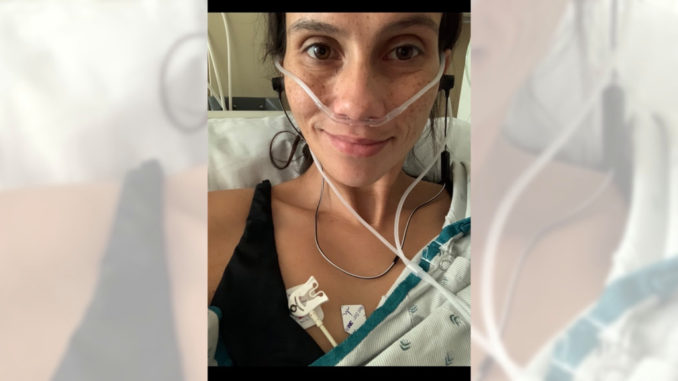
Loren Pennington was 31, regularly running up to 7 miles in addition to other exercises, with no signs of health problems. She wore her mask regularly and maintained social distance.
Based on popular perceptions, she had nothing to fear from the novel coronavirus.
But when she detected a fever in May, her heart sank. She knew she had COVID-19, even if she didn’t yet know her temperature would stay elevated for 22 days, she wouldn’t see her 5-year-old son for over a month, and she wouldn’t be hitting her previous running paces until late August.
“It was scary. You feel like you’re drowning,” Pennington said. “You can’t lay on your back, you can’t lay on your sides, you can’t sit up, you can’t stand up. The only position I was able to breathe — even with that high-flow oxygen machine — was flat on my stomach. You can get to a level of panic.”
Pennington, who has residences in Riverside and Ventura, is married to Dr. Troy Pennington, an emergency-room doctor at Arrowhead Regional Medical Center in Colton. He had been on the frontline, and more recently has made coronavirus educational videos for the county.
When his wife’s breathing difficulties got worse, he took her to Arrowhead Regional — which is run by San Bernardino County — where they ruled out a few diseases. She also tested negative for the coronavirus twice, but they still thought that was the best diagnosis — something they’d later confirm when she tested positive for the antibodies that showed her body had defeated the virus.
More controversial, Dr. Pennington said, was the decision to treat her with steroids. Early studies were pointing toward that being successful, but more conclusive studies wouldn’t come until later.
He also took his wife home — after lengthy consultations with colleagues who had battled COVID-19 in the Inland Empire and in New York, then the hot spot — in part to avoid having her put on a ventilator.
In the master bedroom, he hooked her up to a different, less-invasive supplemental breathing device.
Loren Pennington saw her husband a few minutes at a time, as he entered in personal protective equipment, gave her food and treatment, then quickly left to decontaminate himself.
“The isolation is horrific,” she said. “No one can sit there and hang out in your room and comfort you while you’re feeling this way. They need to do what they can do for you and then get out.”
That also meant the only time she saw her son, Beau, was on FaceTime.
That was a major change for Beau, who rarely is separated from his stay-at-home mother for even a meal.
And it was hard for her husband, too, in ways he tried not to show at the time. Both had been as careful as possible to avoid getting the virus, but until he took time off to care for her, he had been around sick patients all day.
Tests showed he was negative, as were other family members, but guilt plagued him.
“I kept thinking, was this my fault?” he said. “I still am troubled by that.”
Pennington also knows his wife is one of the lucky ones. Many who got COVID-19 at that time have since died — more than 1,000 deaths in Riverside County, and 745 deaths in San Bernardino County, as of Friday, Sept. 4.
That would be far worse if hospitals become too crowded to provide proper treatment, as they nearly did in July and could as flu season takes additional beds, he said.
Others, including people he knows, have officially recovered but still have trouble breathing and thinking, he said.
“We still have people thinking this is ‘just the flu,’” he said. “By the time they come to the hospital, they have a come-to-Jesus moment, but by then it’s too late.”




